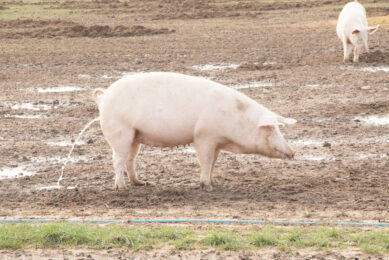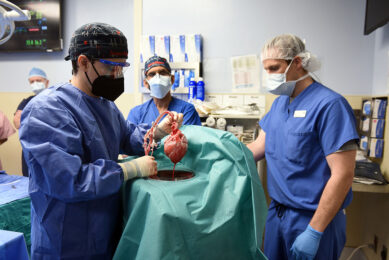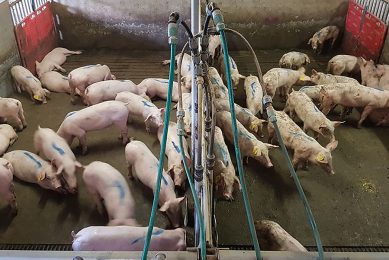Swine dysentery eradication – some practical considerations
In recent months we have seen an increase in swine dysentery cases in the UK and frequent discussions about what should we do. Should we eradicate or slaughter out?
In recent months we have seen an increase in swine dysentery cases in the UK and frequent discussions about what should we do. Should we eradicate or slaughter out?
When swine dysentery strikes a herd for the first time, especially in sow herds, there is an increase in diarrhoea, possibly a drop off in fertility and increase in returns to oestrus and occasionally sow deaths.
This is especially the case in outdoor herds and the early cases can be easily missed. Often there is not the bloody diarrhoea and mucus that we associate with swine dysentery in the growing pig. In some herds in primary breakdown though, I have seen piglets with bloody scour, while still suckling at 2-3 weeks of age.
As the sow has no immunity, there are no protective antibodies being produced in the milk and the incubation period (time from infection to clinical disease) is approximately 7-21 days.
Confirming infection
If diarrhoea is seen in sows, faecal samples should be sent off for identification of Brachyspira hyodysenteriae, the casual agent. In the UK, we are fortunate as we can confirm the infection quickly by using PCR tests on the faeces or the older fluorescent antibody test (FAT).
Initial diagnosis of the disease can be confirmed later by culture and identification, which can take several days. The culture of B. hyodysenteriae is important so that a minimum inhibitory concentration (MIC) test can be carried out on the organism to see which antibiotic to use.
Entrance
While this is going on, it is essential to determine how the disease got onto the farm in the first place, to prevent it happening again.
• Have any animals, gilts or boars been bought in recently?
• Has there been swine dysentery on other parts of the farm e.g. the finishers, especially in three-site production systems?
• Has someone used the same lorry to transport pigs and not cleaned and disinfected properly?
• Are there a lot of staff movements or shared equipment and a lack of cleaning in between?
• How near is the neighbouring farm and have they got dysentery?
Source of infection
We have had an outbreak in the UK, brought on by the purchase of infected weaners from another area. This source infected neighbouring farms, traced by lorry use and spread to neighbouring outdoor breeder farms, probably by seagulls.
This then spread down to the nurseries and finisher units, so that in the end nine farms were infected. Although embarrassing, it is a good idea to advise your neighbouring farms of any problem so they can tighten up on their own biosecurity.
Immune
If gilts have been infected they are probably immune when they arrive, but might still be carrying the organism. In this case, usually the older sows break with dysentery. If the older sows are infected and clean gilts are brought into the herd, the gilts usually go down with dysentery.
Especially, in chronically infected weaner producers where the sow herd is immune, they may not see clinical disease, as they do not have growing pigs on the farm and the disease does not usually develop before six weeks of age in weaners.
Eradication?
So should one try to eradicate the disease or slaughter out? This is a difficult question and only one that can be assessed by the farmer and vet together. Eradication programmes have been generally successful, especially using partial depopulation of all growing and finishing stock. Many breeding herds these days are part of a three-site set up, so effectively have partially depopulated.
The next question is, to which antimicrobial is the organism susceptible. In the EU we only have valnemulin, tiamulin, lincomycin, tylvalosin and tylosin and usually the former is the most active and the latter the most resistant. It is advisable to have an MIC test carried out on the organism isolated from the farm as an extra check.
Susceptibility
We have recently been looking at the susceptibility (MIC) patterns of B. hyodysenteriae isolates to tiamulin and the concentrations of the antibiotic achieved in the colon, where the organism lives (see Figure 1).
Figure 1. Tiamulin MICs against B. hyodysenteriae and colon concentrations after in feed inclusion at 40, 100, 150 and 200ppm – equivalent to 2, 5, 7.5 and 10 mg/kg bodyweight.
 |
Brachyspira with MICs upto 0.5µg/ml are inhibited by tiamulin in the feed at 40ppm (prevention level) but you really need higher concentrations from 150 ppm up to 200 ppm to treat and eliminate the infection.
Adjusting feed inclusion rates
Once the MIC reaches 8 µg/ml or above then tiamulin is unlikely to be effective. The in-feed inclusion rates need to be adjusted to ensure the right dose rate for dry and lactating sows is achieved (possibly 5 and 2.5 times respectively). If the isolate is resistant to all antibiotics then the best option is to depopulate the herd, to stop the bacterium spreading to other herds and producers.
Swine dysentery can be successfully eradicated from a breeding herd but you need a susceptible Brachyspira isolate and to get sufficient medication into the pigs for long enough to eliminate the infection from the pigs and farm environment.











